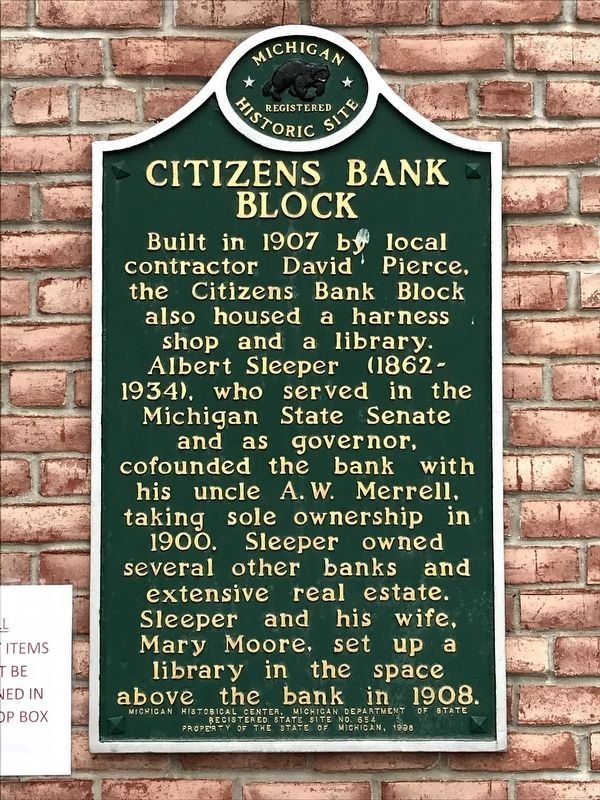Huron City
During the mid-1850s the firm of R. B. Hubbard and Company, which included Connecticut-born entrepreneurs Langdon Hubbard, his brother Watson, and cousin Rollin B., built a steam-powered sawmill on Willow Creek. The company town they developed was named Huron City in 1861.
Great Fire of 1881
Small fires were burning in the forests of the Thumb, tinder-dry after a long, hot summer, when a gale swept in from the southwest on September 5, 1881. Fanned into an inferno, the fires raged for three days. A million acres were devastated in Sanilac and Huron Counties alone.
Frank Murphy
Frank Murphy was Associate Justice of the U. S. Supreme Court from 1940 until his death in 1949. His earlier career included service as a Judge in the Detroit Recorder’s Court and instructor in law at the University of Detroit in the twenties. In the following decade, he was Mayor of Detroit, U. S. Governor-General in the Philippines, Governor of Michigan, and Attorney General of the United States.
Citizens Bank Block
Built in 1907 by local contractor David Pierce, the Citizens Bank Block also housed a harness shop and a library. Albert Sleeper (1862-1934), who served in the Michigan State Senate and as governor, co-founded the bank with his uncle A. W. Merrell, taking sole ownership in 1900. Sleeper owned several other banks and extensive real estate.
Charles G. Learned (Garfield Inn)
Around 1857 Charles G. Learned purchased several thousand acres of pine land in Michigan’s Thumb area. With profits from his lumbering and farming enterprises, Learned enlarged and updated this house in the French Second Empire style. In the 1860s Ohio congressman, later president, James A. Garfield, a family friend, was a frequent guest here.
Old Town Hall and Masonic Temple
The village of Lexington and the local Masonic Lodge combined their efforts and finances to build this three-story Italianate structure in 1876. The village owned the first two floors (the fire department and the opera house); the Masons, the third floor.
Hugh McCurdy Park
Hugh McCurdy (1829-1908), a native of Scotland, immigrated with his parents to Birmingham, Michigan, in 1837. He first worked as a cooper’s apprentice, and after reading the law was admitted to the Michigan bar in 1854 and practised law in Pontiac. Soon after moving to Corunna in 1855, he was appointed Shiawassee County prosecutor. He was elected probate judge in 1860, state senator in 1864, and mayor of Corunna in 1880 and 1887.
Grand Trunk Railroad Depot - Imlay City
The Port Huron & Lake Michigan Railroad, later the Grand Trunk Western, arrived here in 1870. The first depot burned in 1917, and makeshift quarters served for a decade. This depot was built in 1927, according to Grand Trunk’s specifications. In 1930 an addition was built on the west end of the depot.
Amos Woodruff House
The Amos and Eliza Woodruff family migrated from Massachusetts to the Flushing area about 1845. During the next five years Woodruff purchased several parcels of land on River Road. In 1852 he acquired this land, which was part of an eighty-acre tract. A prosperous farmer and landowner, Woodruff was a civic leader who contributed to the development of Flushing.
Caro Masonic Temple
One of the first brick buildings on Caro’s main street, the structure was built by businessman and philanthropist Charles Montague as a bank and general store. When the building was enlarged in 1887, the entire second story became the Masonic Temple.
Bay Port Fishing District
Once known as one of the largest freshwater commercial fishing ports in the world, Bay Port retains a commercial fishery that operates much as it did in the past.
Steam Railroading Institute
The Steam Railroading Institute is dedicated to educate the public about steam era railroading in Michigan and the Great Lakes region. This includes the preservation of the skills and technology for maintaining steam locomotives by operating steam era equipment and providing the experience of steam locomotives in actual operation.
Durand Union Station
The depot is the home of the Michigan Railroad History Museum, an educational and entertaining source of Michigan’s rich railroad history. The museum gallery features new exhibits several times per year to pay tribute to the colorful heritage of the railroader and to the contribution of Michigan’s railroads to lumber, mining, agriculture, and industry.
Montrose Historical and Telephone Pioneer Museum
Michigan's only telephone museum with hands on working exhibits and antique telephone equipment and historical highlights of Montrose, MI
Whaley House Museum
WHHM is the historic home of Robert J. Whaley and Mary McFarlan-Whaley, who moved to Flint in 1885. Together, they purchased the property on Kearsley street and renovated the house into a classic Victorian home. Their home is now a historic house museum that presents a wide range of public programs and events and is available for private rental.
Vassar Historical Museum
Our museum is located on South Main Street. It's housed in a local historical house which was moved to this location for the museum. We are always working to improve both the building and landscaping as well as the exhibits offered within.
Imlay City Historical Museum
The Imlay City museum is owned and operated by the Imlay City Historical Commission, which collects, preserves, and interprets the heritage of the Imlay City area and instills an appreciation of local history through exhibits and educational programs.
Lapeer County Historic Courthouse
The Lapeer County Courthouse is now the oldest courthouse in Michigan which serves its original purpose. It remains a fine example of the dignified Doric style. The courthouse can be rented for your events.
Thumb Octagon Barn & Agricultural Museum
Our vision is to develop the Thumb Octagon Barn complex for the community as an agricultural museum and educational center open to individuals, families and student groups to educate and stimulate awareness of our agricultural heritage.



















